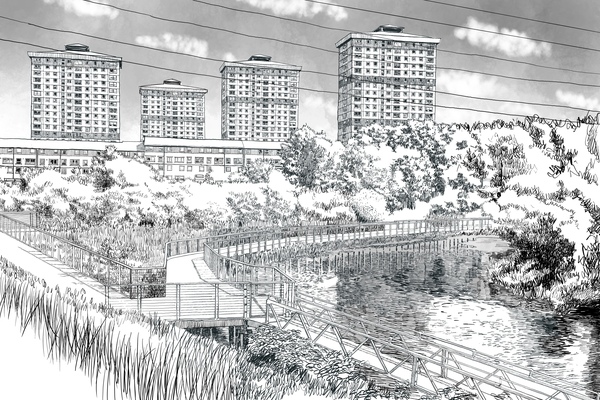Candidate: Claypits Local Nature Reserve
Location: Glasgow, Scotland
Category: The Great Place Award (Winner)
Year: 2023
Other finalists in this category: Gloucester Docks, Gloucester and Spanish City, Whitley Bay
Judges' comments:
“The Claypits Local Nature Reserve has transformed derelict, post-industrial land into a valued community asset. It demonstrates exceptional sustainable design and climate adaptation, with its ‘smart canal’, sustainable urban drainage, and measures to enhance biodiversity. Beyond its strong environmental credentials, the project greatly promotes connectivity, permeability, and legibility within its urban context. All this is being achieved through close collaboration with local communities and between the various project partners.” - Francis Newton AoU, Great Place Lead Assessor
Introduction
The Claypits Local Nature Reserve lies to the northern fringes of Glasgow’s city centre*
Sitting within a densely populated urban area, this 7-hectare reserve forms an interface between the inner-city communities of Hamiltonhill, Firhill, Ruchill and Woodside.
The area has recently been subject to a major £7.6 million publicly funded regeneration project led by Scottish Canals, opening in July 2021. This has seen derelict, post-industrial land and canal being repurposed into a local nature reserve, which is now serving as a valuable recreational space and community asset.
The project has created a network of woodland footpaths and cycle paths, hard landscaping, a sliding pedestrian bridge, boardwalks, viewpoints, play and activity components. Works have also incorporated significant SuDS and utility infrastructure including a ‘smart canal’ to help support the development of housing in adjacent communities including residential moorings on the canal. But central to the project has been environmental protection and habitat improvement, including extensive tree planting and creation of wildflower meadow.
The principal focus of the project is on the Glasgow Branch of the Forth and Clyde Canal, which dates from the late 1700s. Historically, Hamiltonhill was a source of clay used to line the canals. When the canals stopped working, the claypits lost their purpose and land became a dump or ‘cowp’. During the 19th and early 20th Centuries the canal was lined with heavy industry including mills, foundrys, glassworks, timber and boatbuilding yards. By the late 20th century this began to decline, the area around the canal became derelict and essentially a ‘no go’ area for many people. But like many landscapes that have lost their purpose, nature began to emerge.
In the early 2000s, a kernel of an idea for a nature reserve began to emerge, to provide nature on people’s doorsteps to support the range of communities adjacent. Various groups in North Glasgow also worked with Glasgow City Council and Scottish Canals to advocate for a new public park, which because it was so wild, would evolve into a local nature reserve.
To advance this thinking, a Glasgow Canal Regeneration Partnership was formed in 2015. This articulated a vision between stakeholders and local communities, for the area to become an attractive greenspace that could be used for multiple health, social, environmental and health benefits.
This vision and objectives were enshrined into planning policy through the Canal Hamiltonhill Development Framework, approved in 2016. The framework has established a long-term strategy for the sustainable development of the area, to tackle issues such as vacant and derelict land, surface water management, connectivity and sustainable housing development.
The framework has also provided backdrop to other regeneration schemes being taken forward in the locality including Spiers Lock, Port Dundas and Sighthill, these connecting people via a green blue network.
*This nomination relates specifically to the Claypits Local Nature Reserve project also acknowledging the adjacent communities North Glasgow which it serves.
Thumbnail illustration of Claypits Local Nature Reserve by David Rudlin AoU, Artist-in-Residence









